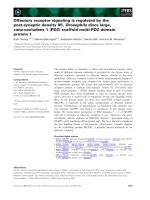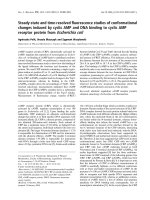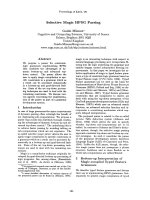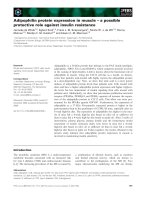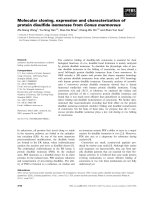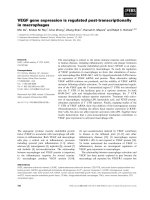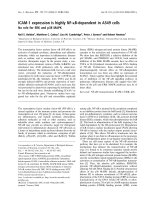Báo cáo khoa học: " Selective receptor expression restricts Nipah virus infection of endothelial cells" pot
Bạn đang xem bản rút gọn của tài liệu. Xem và tải ngay bản đầy đủ của tài liệu tại đây (2.09 MB, 6 trang )
BioMed Central
Page 1 of 6
(page number not for citation purposes)
Virology Journal
Open Access
Short report
Selective receptor expression restricts Nipah virus infection of
endothelial cells
Stephanie Erbar, Sandra Diederich and Andrea Maisner*
Address: Institute of Virology, Philipps University of Marburg, Marburg, Germany
Email: Stephanie Erbar - ; Sandra Diederich - ;
Andrea Maisner* -
* Corresponding author
Abstract
Nipah virus (NiV) is a highly pathogenic paramyxovirus that causes severe diseases in animals and
humans. Endothelial cell (EC) infection is an established hallmark of NiV infection in vivo. Despite
systemic virus spread via the vascular system, EC in brain and lung are preferentially infected
whereas EC in other organs are less affected. As in vivo, we found differences in the infection of EC
in cell culture. Only brain-derived primary or immortalized EC were found to be permissive to NiV
infection. Using a replication-independent fusion assay, we could show that the lack of infection in
non-brain EC was due to a lack of receptor expression. The NiV entry receptors ephrinB2 (EB2)
or ephrinB3 were only expressed in brain endothelia. The finding that EB2 expression in previously
non-permissive aortic EC rendered the cells permissive to infection then demonstrated that EB2 is
not only necessary but also sufficient to allow the establishment of a productive NiV infection. This
strongly suggests that limitations in receptor expression restrict virus entry in certain EC subsets
in vivo, and are thus responsible for the differences in EC tropism observed in human and animal
NiV infections.
Findings
Nipah virus (NiV) was identified in 1999 after an out-
break of fatal encephalitis among pig farmers in Malaysia
[1]. Fruit bats of the genus Pteropus were identified as nat-
ural reservoir [2]. Together with the closely related Hendra
virus, NiV represents the genus Henipavirus within the
paramyxovirus family [3]. In contrast to most paramyxo-
viruses, henipaviruses cause diseases in many mammalian
species including pigs, cats, horses, hamsters, guinea pigs
and humans [4-7], and are classified as biosafety level 4
(BSL-4) pathogens.
Histopathological studies of NiV infections revealed that
vascular endothelial cells (EC) are the predominant target
cells of NiV [4,5,8,9]. Clinical disease, however, was
affected by further tropism to non-vascular tissues (e.g.
neurons in the brain). In humans, a widespread vasculitis
is observed and NiV infection and syncytia formation is
believed to trigger thrombosis and necrosis in the
involved vessels. However, the extent of EC destruction
due to NiV infection varies in different organs, and was
found to be most prominent in small vessels in the central
nervous system (CNS), the lung and the spleen, whereas
other organs are less or not at all affected (liver) [1]. The
capacity of EC in different organs to support virus replica-
tion is thus an important determinant for the clinical out-
come of NiV infection. Aim of this study was to elucidate
which cellular factor(s) determine what kind of EC can be
productively infected. Properties of EC from different
organs are known to be heterogenous [10], and several
Published: 26 November 2008
Virology Journal 2008, 5:142 doi:10.1186/1743-422X-5-142
Received: 30 October 2008
Accepted: 26 November 2008
This article is available from: />© 2008 Erbar et al; licensee BioMed Central Ltd.
This is an Open Access article distributed under the terms of the Creative Commons Attribution License ( />),
which permits unrestricted use, distribution, and reproduction in any medium, provided the original work is properly cited.
Virology Journal 2008, 5:142 />Page 2 of 6
(page number not for citation purposes)
cell- or organ-type specific host components are described
to either enhance or to interfere with different steps of
viral replication such as surface-expressed C-type lectins
(DC-SIGNR, LSECtin) which can promote virus attach-
ment prior to receptor binding [11,12], or intracellular
factors influencing uncoating, viral RNA replication, viral
protein synthesis or virus assembly [13-16]. Besides these
host cell factors, major candidates deciding on cell tro-
pism are specific viral receptors. In the case of NiV, the
main entry receptor is ephrinB2 (EB2) [17,18], a trans-
membrane protein which is highly conserved among all
mammalian species. EB2 is a ligand of EphB4 receptors
and is involved in neurogenesis and angiogenesis [19-22].
In the vasculature, EB2 is selectively expressed on arterial
EC to fulfill its function in angiogenesis and neovascular-
ization [23]. Even if EB2 is generally expressed in arteries
and arterioles, the expression levels vary greatly in differ-
ent organs. Highest levels of EB2 expression were reported
in lung and colon, EB2 expression in brain tissue was only
middle and EB2 mRNA levels detected in spleen and liver
were low [24]. Since this in vivo expression profile does
not correlate with the NiV organ tropismus, it remains to
be determined if differences in organ-specific host factors
other than receptor expression are responsible for the
observed differences in EC infection.
First, we assessed if the differences in EC infection
reported for in vivo infection can also be observed in cell
culture. For this we used the following model EC: PBMEC
(primary porcine microvascular endothelial cells) freshly
isolated from pig brain according to the protocol
described in [25]; HBMEC (human brain endothelial cells
[26]); PAEC (porcine aortic endothelial cells) [27];
MyEnd cells (mouse myocard endothelial cells) [28] and
Ea.hy 926 cells derived from human umbilical vein
endothelial cells [29]. As a control, Vero cells (permissive
to NiV infection) and non-permissive HeLa cells were
used [30]. For infection studies, cells were seeded on cov-
erslips, grown to confluency and subsequently infected
with NiV at a multiplicity of infection (MOI) of 0.2. All
work with live virus was performed under BSL-4 condi-
tions as described previously [31]. At 24 h post infection
(p.i.), cells were fixed with 4% paraformaldehyde for 48 h.
Virus-positive cells were detected after permeabilization
using a NiV-specific guinea pig antiserum and rhodamine-
conjugated secondary antibodies. As expected, large
multinucleated syncytia were found in control Vero cells
whereas HeLa cells were not infected. Among the tested
model EC, only PBMEC and HBMEC allowed NiV replica-
tion. In both cell types, NiV-positive syncytia could be
detected. All other EC types did not show any sign of
infection. Supporting the finding that only PBMEC and
HBMEC are permissive to NiV infection, viral RNA was
detected by RT-PCR in the cell supernatants (Fig. 1B).
To determine if the lack of productive NiV infection in
non-brain derived EC is due to an intracellular replication
block, or is rather due to a defective receptor interaction
preventing virus entry, we analyzed the ability of the dif-
ferent cells to support NiV glycoprotein mediated fusion
by an overlay fusion assay. NiV G and F proteins coex-
pressed on the cell surface mediate cell-to-cell fusion with
contacting receptor-positive cells; this assay therefore
allows testing of cell lines for functional receptor expres-
sion independent of NiV replication. HeLa cells which do
not support NiV-mediated fusion were transfected with
plasmids encoding for the NiV glycoproteins F and G [32].
At 22 h post transfection (p.t.), F/G-expressing HeLa cells
were detached by trypsin/EDTA treatment, and 1 × 10
5
cells were overlayed on EC monolayers grown on cover-
slips. 22 h later, cell-to-cell fusion was visualized by
Giemsa staining. Fig. 1C clearly demonstrates that syncy-
tia formation is only supported by Vero cells (positive
control), as well as by PBMEC and HBMEC, the two brain-
derived EC. Neither aortic, myocard nor umbilical cord
EC (PAEC, MyEnd, Ea.hy 926) fused with NiV glycopro-
tein expressing HeLa cells suggesting that deficient replica-
tion in these cells is due to the lack of functional NiV
receptors.
To confirm that variations in receptor expression are
responsible for the observed differences in EC infection,
EB2 expression in the different cells was analyzed by sur-
face immunostaining. For this, cells were fixed with 4%
paraformaldehyde, incubated with a recombinant mouse
EphB4/Fc, a soluble EB2 receptor fused to the Fc region of
human IgG (R&D Systems) and rhodamine-coupled sec-
ondary antibodies [31]. As shown in Fig. 2A, EB2 staining
was only found in Vero cells, HBMEC and PBMEC. To
confirm the lack of EB2 expression in the cells non-per-
missive to NiV infection, RNA was isolated from 5 × 10
5
of each cell line using an RNeasy Mini kit (Qiagen). Sub-
sequently, RT-PCR was performed using EB2-specific
primers [33]. In agreement with the immunostaining, Fig.
2B clearly demonstrates that EB2 mRNA was only present
in Vero cells and brain-derived EC.
It was reported that in addition to EB2, ephrinB3 (EB3)
may serve as alternative receptor for NiV. In vivo, EB3 is
expressed in the CNS and likely accounts for specific
aspects of NiV pathology in the brain [34]. Even if EB3 is
not involved in angiogenesis [35], and is thus not
assumed to be expressed on EC in vivo, expression of EB3
in our model EC was analyzed by an EB3-specific RT-PCR
[33]. Fig. 2C shows that besides Vero cells, only PBMEC
express small amounts of EB3 mRNA. This revealed that
EB3 is not only expressed in brain parenchyma but also in
brain EC and might therefore be used as alternate receptor
in this cell type in the absence of EB2. However, EB3
expression is most likely not involved in NiV binding and
Virology Journal 2008, 5:142 />Page 3 of 6
(page number not for citation purposes)
NiV infection and NiV glycoprotein-mediated cell-to-cell fusion in different model ECFigure 1
NiV infection and NiV glycoprotein-mediated cell-to-cell fusion in different model EC. PBMEC, HBMEC, PAEC,
MyEnd, Ea.hy 926 and control Vero and HeLa cells were infected with NiV at a MOI of 0.2. (A) At 24 h p.i., cells were fixed,
incubated with a NiV-specific guinea pig antiserum and visualized with rhodamine-conjugated secondary antibodies. Nuclei
were counterstained with DAPI. (B) At 48 h p.i., viral RNA was isolated from supernatants of infected cells. RT-PCR was per-
formed using NP-specific primers (NPfor binds at bp 1160–1179 and NPrev binds at bp 1271–1292). (C) HeLa cells were
cotransfected with plasmids encoding the NiV glycoproteins F and G and were incubated at 33°C. 22 h after transfection, con-
trol cells and the different EC types were overlayed with NiV F- and G-expressing HeLa cells. 24 h later, cell-to-cell fusion was
visualized by Giemsa staining. Magnification, ×20.
Virology Journal 2008, 5:142 />Page 4 of 6
(page number not for citation purposes)
syncytia formation in our PBMEC, because these cells
express high amounts of EB2, and it was shown that NiV-
G binds to EB2 with much higher affinity [34].
To analyze if receptor expression is the only determinant
responsible for selective infection of brain-derived EC, or
if there are further brain-specific cellular factors responsi-
ble for this tropism, we analyzed NiV infection of aortic
EC (PAEC) which had been stably transfected with the
human EB2 gene (PAEC-EB2) [27]. As shown in Fig. 3A,
EB2 is readily expressed on the surface of these cells. We
then infected PAEC-EB2 with NiV (MOI of 0.2), visualized
virus-positive cells by immunostaining at 24 h p.i. and
analyzed virus release into the supernatant by RT-PCR at
48 h p.i In contrast to wildtype PAEC, PAEC-EB2 clearly
supported productive NiV infection. NiV-positive syncytia
were clearly detectable in PAEC-EB2 (Fig. 3B) and viral
RNA was found in cell supernatants (Fig. 3C). This
revealed that EB2 expression in non-permissive PAEC ren-
dered these cells fully permissive to NiV infection, and
thus indicates that EB2 expression is necessary and suffi-
cient for NiV infection of EC. Together, our results clearly
indicate a strict correlation of EB2 expression in EC and
permissiveness to NiV infection in cell culture. Only
brain-derived primary or immortalized EC were receptor-
positive and supported NiV glycoprotein-mediated fusion
EB2 and EB3 expression in model ECFigure 2
EB2 and EB3 expression in model EC. (A) EC were cultured on coverslips and immunostaining was performed using
recombinant EphB4/Fc and rhodamine-conjugated secondary antibodies. Nuclei were visualized by DAPI staining. Magnification,
×100. (B) mRNA was extracted from 5 × 10
5
cells by standard procedures and subjected to RT-PCR with EB2-specific primers.
(C) RT-PCR with EB3-specific primers.
Virology Journal 2008, 5:142 />Page 5 of 6
(page number not for citation purposes)
as well as NiV infection. Even if additional host factors
such as interferon-induced antiviral proteins [16,36]
might influence NiV infection of EC in different organs in
vivo, our data strongly suggest that variations in the recep-
tor expression are the important key factor for EC tropism
in the course of systemic NiV infections.
Competing interests
The authors declare that they have no competing interests.
Authors' contributions
SE carried out most of the experiments and helped to draft
the manuscript. SD performed all work under BSL-4 con-
ditions. AM designed the study, helped with analysis and
the interpretation of the data and drafted the manuscript.
All authors read and approved the final manuscript.
Acknowledgements
We thank M. Czub, H. Weingartl, and H. Feldmann for providing the anti-
NiV guinea pig sera, and H. Augustin and D. Pfaff for the PAEC-EB2 cells.
This work was supported by grants of the German Research Foundation
(DFG) to A.M. (GK 1216 and SFB 593 TP B11).
References
1. Chua KB, Goh KJ, Wong KT, Kamarulzaman A, Tan PS, Ksiazek TG,
Zaki SR, Paul G, Lam SK, Tan CT: Fatal encephalitis due to Nipah
virus among pig-farmers in Malaysia. Lancet 1999,
354(9186):1257-1259.
2. Yob JM, Field H, Rashdi AM, Morrissy C, Heide B van der, Rota P, bin
Adzhar A, White J, Daniels P, Jamaluddin A, et al.: Nipah virus infec-
tion in bats (order Chiroptera) in peninsular Malaysia. Emerg
Infect Dis 2001, 7(3):439-441.
3. Wang L, Harcourt BH, Yu M, Tamin A, Rota PA, Bellini WJ, Eaton BT:
Molecular biology of Hendra and Nipah viruses. Microbes Infect
2001, 3(4):279-287.
4. Hooper P, Zaki S, Daniels P, Middleton D: Comparative pathology
of the diseases caused by Hendra and Nipah viruses. Microbes
Infect 2001, 3(4):315-322.
5. Middleton DJ, Westbury HA, Morrissy CJ, Heide BM van der, Russell
GM, Braun MA, Hyatt AD: Experimental Nipah virus infection
in pigs and cats. J Comp Pathol 2002, 126:2-3.
6. Williamson MM, Hooper PT, Selleck PW, Gleeson LJ, Daniels PW,
Westbury HA, Murray PK: Transmission studies of Hendra virus
(equine morbillivirus) in fruit bats, horses and cats. Aust Vet J
1998, 76(12):813-818.
7. Wong KT, Shieh WJ, Kumar S, Norain K, Abdullah W, Guarner J,
Goldsmith CS, Chua KB, Lam SK, Tan CT, et al.: Nipah virus infec-
tion: pathology and pathogenesis of an emerging paramyxo-
viral zoonosis. Am J Pathol 2002, 161(6):2153-2167.
8. Torres-Velez FJ, Shieh WJ, Rollin PE, Morken T, Brown C, Ksiazek
TG, Zaki SR: Histopathologic and immunohistochemical char-
acterization of Nipah virus infection in the guinea pig. Vet
Pathol 2008, 45(4):576-585.
9. Wong KT, Grosjean I, Brisson C, Blanquier B, Fevre-Montange M,
Bernard A, Loth P, Georges-Courbot MC, Chevallier M, Akaoka H, et
al.: A golden hamster model for human acute Nipah virus
infection. Am J Pathol 2003, 163(5):2127-2137.
10. Zetter BR: Endothelial heterogeneity: Influence of vessel size,
organ localization and species specificity on the properties of
cultured endothelial cells. In Endothelial Cells Volume 2. Edited by:
Ryan US e. Boca Raton, FL: CRC Press; 1988:63-79.
11. Gramberg T, Soilleux E, Fisch T, Lalor PF, Hofmann H, Wheeldon S,
Cotterill A, Wegele A, Winkler T, Adams DH, et al.: Interactions of
LSECtin and DC-SIGN/DC-SIGNR with viral ligands: Differ-
ential pH dependence, internalization and virion binding.
Virology 2008, 373(1):189-201.
12. Simmons G, Reeves JD, Grogan CC, Vandenberghe LH, Baribaud F,
Whitbeck JC, Burke E, Buchmeier MJ, Soilleux EJ, Riley JL, et al.: DC-
SIGN and DC-SIGNR bind ebola glycoproteins and enhance
infection of macrophages and endothelial cells. Virology 2003,
305(1):115-123.
13. Holmes RK, Malim MH, Bishop KN: APOBEC-mediated viral
restriction: not simply editing? Trends Biochem Sci 2007,
32(3):118-128.
14. McFadden G: Poxvirus tropism. Nat Rev Microbiol 2005,
3(3):201-213.
15. Nisole S, Stoye JP, Saib A: TRIM family proteins: retroviral
restriction and antiviral defence. Nat Rev Microbiol 2005,
3(10):799-808.
16. Sadler AJ, Williams BR: Interferon-inducible antiviral effectors.
Nat Rev Immunol 2008, 8(7):559-568.
17. Bonaparte MI, Dimitrov AS, Bossart KN, Crameri G, Mungall BA,
Bishop KA, Choudhry V, Dimitrov DS, Wang LF, Eaton BT, et al.:
Ephrin-B2 ligand is a functional receptor for Hendra virus
and Nipah virus. Proc Natl Acad Sci USA 2005,
102(30):10652-10657.
18. Negrete OA, Levroney EL, Aguilar HC, Bertolotti-Ciarlet A, Nazarian
R, Tajyar S, Lee B: EphrinB2 is the entry receptor for Nipah
virus, an emergent deadly paramyxovirus. Nature 2005,
436(7049):401-405.
NiV infection of EB2 expressing PAE cells (PAEC-EB2)Figure 3
NiV infection of EB2 expressing PAE cells (PAEC-
EB2). (A) PAEC and PAEC-EB2 cells were immunostained
for EB2 as described in the legend to Fig. 2B. Magnification,
×100. (B) PAEC and PAEC-EB2 were infected with NiV at a
MOI of 0.2. At 24 h p.i., cells were fixed and immunostaining
was performed as described in the legend to Fig. 1A. Magnifi-
cation, ×20. (C) 48 h p.i., mRNA was isolated from the cell
supernatant, and RT-PCR was performed with NP-specific
primers.
Publish with BioMed Central and every
scientist can read your work free of charge
"BioMed Central will be the most significant development for
disseminating the results of biomedical research in our lifetime."
Sir Paul Nurse, Cancer Research UK
Your research papers will be:
available free of charge to the entire biomedical community
peer reviewed and published immediately upon acceptance
cited in PubMed and archived on PubMed Central
yours — you keep the copyright
Submit your manuscript here:
/>BioMedcentral
Virology Journal 2008, 5:142 />Page 6 of 6
(page number not for citation purposes)
19. Augustin HG, Reiss Y: EphB receptors and ephrinB ligands: reg-
ulators of vascular assembly and homeostasis. Cell Tissue Res
2003, 314(1):25-31.
20. Gale NW, Baluk P, Pan L, Kwan M, Holash J, DeChiara TM, McDonald
DM, Yancopoulos GD: Ephrin-B2 selectively marks arterial ves-
sels and neovascularization sites in the adult, with expres-
sion in both endothelial and smooth-muscle cells. Dev Biol
2001, 230(2):151-160.
21. Palmer A, Klein R: Multiple roles of ephrins in morphogenesis,
neuronal networking, and brain function. Genes Dev 2003,
17(12):1429-1450.
22. Poliakov A, Cotrina M, Wilkinson DG: Diverse roles of eph recep-
tors and ephrins in the regulation of cell migration and tissue
assembly. Dev Cell 2004, 7(4):465-480.
23. Shin D, Garcia-Cardena G, Hayashi S, Gerety S, Asahara T, Stavrakis
G, Isner J, Folkman J, Gimbrone MA Jr, Anderson DJ: Expression of
ephrinB2 identifies a stable genetic difference between arte-
rial and venous vascular smooth muscle as well as endothe-
lial cells, and marks subsets of microvessels at sites of adult
neovascularization. Dev Biol 2001, 230(2):139-150.
24. Hafner C, Schmitz G, Meyer S, Bataille F, Hau P, Langmann T, Diet-
maier W, Landthaler M, Vogt T: Differential gene expression of
Eph receptors and ephrins in benign human tissues and can-
cers. Clin Chem 2004, 50(3):490-499.
25. Bowman PD, Ennis SR, Rarey KE, Betz AL, Goldstein GW: Brain
microvessel endothelial cells in tissue culture: a model for
study of blood-brain barrier permeability. Ann Neurol 1983,
14(4):396-402.
26. Stins MF, Gilles F, Kim KS: Selective expression of adhesion mol-
ecules on human brain microvascular endothelial cells. J Neu-
roimmunol 1997, 76:1-2.
27. Fuller T, Korff T, Kilian A, Dandekar G, Augustin HG: Forward
EphB4 signaling in endothelial cells controls cellular repul-
sion and segregation from ephrinB2 positive cells. J Cell Sci
2003, 116:2461-2470.
28. Golenhofen N, Ness W, Wawrousek EF, Drenckhahn D: Expres-
sion and induction of the stress protein alpha-B-crystallin in
vascular endothelial cells.
Histochem Cell Biol 2002,
117(3):203-209.
29. Edgell CJ, McDonald CC, Graham JB: Permanent cell line
expressing human factor VIII-related antigen established by
hybridization. Proc Natl Acad Sci USA 1983, 80:3734-3737.
30. Moll M, Diederich S, Klenk HD, Czub M, Maisner A: Ubiquitous
activation of the Nipah virus fusion protein does not require
a basic amino acid at the cleavage site. J Virol 2004,
78(18):9705-9712.
31. Diederich S, Thiel L, Maisner A: Role of endocytosis and cathep-
sin-mediated activation in Nipah virus entry. Virology 2008.
32. Diederich S, Moll M, Klenk HD, Maisner A: The nipah virus fusion
protein is cleaved within the endosomal compartment. J Biol
Chem 2005, 280(33):29899-29903.
33. Kim I, Ryu YS, Kwak HJ, Ahn SY, Oh JL, Yancopoulos GD, Gale NW,
Koh GY: EphB ligand, ephrinB2, suppresses the VEGF- and
angiopoietin 1-induced Ras/mitogen-activated protein
kinase pathway in venous endothelial cells. Faseb J 2002,
16(9):1126-1128.
34. Negrete OA, Wolf MC, Aguilar HC, Enterlein S, Wang W, Muhl-
berger E, Su SV, Bertolotti-Ciarlet A, Flick R, Lee B: Two key resi-
dues in ephrinB3 are critical for its use as an alternative
receptor for Nipah virus. PLoS Pathog 2006, 2(2):e7.
35. Kullander K, Butt SJ, Lebret JM, Lundfald L, Restrepo CE, Rydstrom
A, Klein R, Kiehn O: Role of EphA4 and EphrinB3 in local neu-
ronal circuits that control walking. Science 2003,
299(5614):1889-1892.
36. Argyris EG, Acheampong E, Wang F, Huang J, Chen K, Mukhtar M,
Zhang H: The interferon-induced expression of APOBEC3G
in human blood-brain barrier exerts a potent intrinsic immu-
nity to block HIV-1 entry to central nervous system. Virology
2007, 367(2):440-451.


